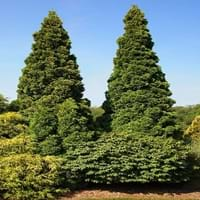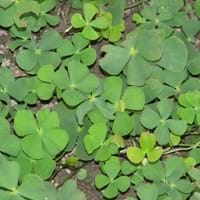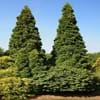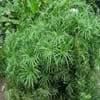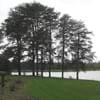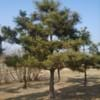Life Span
Perennial
Perennial
Type
Needled or Scaled Evergreen
Aquatics
Origin
Northeastern United States, Mid-Atlantic United States, Southeastern United States, North-Central United States, Central United States, Canada
Australia
Types
Not Available
Not Available
Habitat
Dry areas, Lake Sides, riparian zones, Slopes, Upland
along watercourse, Banks, Lake Sides, Near ponds
USDA Hardiness Zone
3-7
7-11
Sunset Zone
A2, A3, H1, H2, 1a, 1b, 2a, 2b, 3a, 3b, 4, 5, 6, 7, 8, 9, 15, 16, 17, 21, 22, 23, 24
21,22
Habit
Pyramidal
Spreading
Flower Color
Yellow, Yellow Brown
Not Available
Flower Color Modifier
Bicolor
Not Available
Fruit Color
Brownish Red, Red
Not Available
Leaf Color in Spring
Green, Dark Green
Light Green, Dark Red
Leaf Color in Summer
Green, Dark Green
Light Green, Dark Red
Leaf Color in Fall
Green, Dark Green
Light Green, Dark Red
Leaf Color in Winter
Green, Dark Green, Brown
Light Green, Gray Green, Dark Red
Leaf Shape
Scale-like imbricate
Round
Plant Season
Spring, Summer, Fall, Winter
Spring, Summer, Fall
Sunlight
Full Sun, Partial Sun
Full Sun, Partial Sun
Growth Rate
Medium
Very Fast
Type of Soil
Loam, Sand
Loam, Sand
The pH of Soil
Acidic, Neutral
Acidic, Neutral, Alkaline
Soil Drainage
Average
Poorly Drained
Bloom Time
Spring
Not Available
Tolerances
Drought
Wet Site
Where to Plant?
Ground
In Water
How to Plant?
Seedlings, Stem Cutting
Spores
Plant Maintenance
Medium
Medium
Watering Requirements
Drought Tolerant, Keep the ground moist but not water-logged, Requires regular watering
Keep immersed in water
In Summer
Lots of watering
Lots of watering
In Spring
Moderate
Moderate
In Winter
Average Water
Average Water
Soil pH
Acidic, Neutral
Acidic, Neutral, Alkaline
Soil Type
Loam, Sand
Loam, Sand
Soil Drainage Capacity
Average
Poorly Drained
Sun Exposure
Full Sun, Partial Sun
Full Sun, Partial Sun
Pruning
Remove damaged leaves, Remove dead branches, Remove dead leaves
Remove damaged leaves, Remove dead branches, Remove dead leaves
Fertilizers
All-Purpose Liquid Fertilizer
All-Purpose Liquid Fertilizer
Pests and Diseases
Citrus leaf miner, Drought, Edema, Gray mold
Not Available
Plant Tolerance
Drought
Drought
Flower Petal Number
Single
Not Available
Fragrant Bark/Stem
Yes
No
Foliage Texture
Medium
Medium
Foliage Sheen
Glossy
Matte
Allergy
Anaphylaxis, Hives, Itchy eyes, Red eyes, Runny nose, Skin rash, sneezing, Watery eyes
Not Applicable
Aesthetic Uses
Showy Purposes
Showy Purposes, Water gardening
Beauty Benefits
Not Available
Not Available
Environmental Uses
Air purification
Air purification
Medicinal Uses
anti rheumatic, Astringent, Diuretic, Expectorant, Tonic
Not Available
Part of Plant Used
Bark, extracted oil, Leaves, Twigs
Seeds, Spores
Other Uses
Medicinal oil, Used as firewood, Used in herbal medicines, Used in Homeopathy
Decoration Purposes, Starch
Used As Indoor Plant
No
No
Used As Outdoor Plant
Yes
Yes
Garden Design
Feature Plant, Foundation, Hedges, Mixed Border, Screening, Wind Break
Container, Water Gardens
Botanical Name
THUJA occidentalis
MARSILEA mutica
Common Name
northern white cedar, swamp cedar, false white ceda
Banded Nardoo, Banded Water Clover, Pepperwort
In Hindi
Thuja occidentalis
Pepperwort
In German
Abendländischer Lebensbaum
Pepperwort
In French
Thuya occidental
Pepperwort
In Spanish
Tuya del Canadá
Pepperwort
In Greek
Thuja occidentalis
Pepperwort
In Portuguese
Thuja occidentalis
Pepperwort
In Polish
Żywotnik_zachodni
Pepperwort
In Latin
Thuja occidentalis
Pepperwort
Phylum
Tracheophyta
Charophyta
Class
Pinopsida
Equisetopsida
Family
Cupressaceae
Marsileaceae
Clade
Not Available
Angiosperms, Eudicots, Rosids
Tribe
Not Available
Lapidieae
Subfamily
Not Available
NA
Properties of White Cedar and Pepperwort
Wondering what are the properties of White Cedar and Pepperwort? We provide you with everything About White Cedar and Pepperwort. White Cedar doesn't have thorns and Pepperwort doesn't have thorns. Also White Cedar does not have fragrant flowers. White Cedar has allergic reactions like Anaphylaxis, Hives, Itchy eyes, Red eyes, Runny nose, Skin rash, sneezing and Watery eyes and Pepperwort has allergic reactions like Anaphylaxis, Hives, Itchy eyes, Red eyes, Runny nose, Skin rash, sneezing and Watery eyes. Compare all the properties and characteristics of these two plants. Find out which of these plant can be used as indoor plant. If you are interested to decorate your house and garden, find out aesthetic uses, compare them and select the plant which will beautify your surrounding. Along with beautification, try comparing medicinal and edible uses of White Cedar and Pepperwort and you can choose the plant having best and most benefits.
Season and Care of White Cedar and Pepperwort
Season and care of White Cedar and Pepperwort is important to know. While considering everything about White Cedar and Pepperwort Care, growing season is an essential factor. White Cedar season is Spring, Summer, Fall and Winter and Pepperwort season is Spring, Summer, Fall and Winter. The type of soil for White Cedar is Loam, Sand and for Pepperwort is Loam, Sand while the PH of soil for White Cedar is Acidic, Neutral and for Pepperwort is Acidic, Neutral, Alkaline.
White Cedar and Pepperwort Physical Information
White Cedar and Pepperwort physical information is very important for comparison. White Cedar height is 90.00 cm and width 90.00 cm whereas Pepperwort height is 250.00 cm and width 610.00 cm. The color specification of White Cedar and Pepperwort are as follows:
White Cedar flower color: Yellow and Yellow Brown
White Cedar leaf color: Green and Dark Green
Pepperwort flower color: Not Available
- Pepperwort leaf color: Light Green and Dark Red
Care of White Cedar and Pepperwort
Care of White Cedar and Pepperwort include pruning, fertilizers, watering etc. White Cedar pruning is done Remove damaged leaves, Remove dead branches and Remove dead leaves and Pepperwort pruning is done Remove damaged leaves, Remove dead branches and Remove dead leaves. In summer White Cedar needs Lots of watering and in winter, it needs Average Water. Whereas, in summer Pepperwort needs Lots of watering and in winter, it needs Average Water.
